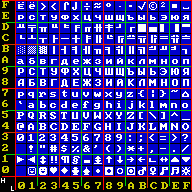
Back نايبل Arabic Нібл BE-X-OLD Nibble Catalan Nibble Czech Nibble Danish Nibble German Nibble Greek Nibble Spanish Näks Estonian نیبل Persian
This article needs additional citations for verification. (April 2015) |

In computing, a nibble[1], or spelled nybble to match byte, is a unit of information that is an aggregation of four-bits; half of a byte/octet[1][2][3]. The unit is alternatively called nyble, nybl, half-byte[4] or tetrade.[5][6] In networking or telecommunications, the unit is often called a semi-octet,[7] quadbit,[8] or quartet.[9][10]
As a nibble can represent sixteen (24) possible values, a nibble value is often shown as a hexadecimal digit (hex digit).[11]. A byte is two nibbles, and therefore, a value can be shown as two hex digits.
Four-bit computers use nibble-sized data for storage and operations; as the word unit. Such computers were used in early microprocessors, pocket calculators and pocket computers. They continue to be used in some microcontrollers. In this context, 4-bit groups were sometimes also called characters[12] rather than nibbles.[1]
- ^ a b c Cite error: The named reference
Intel_1974_MCS-40was invoked but never defined (see the help page). - ^ Cite error: The named reference
Hall_1980was invoked but never defined (see the help page). - ^ Cite error: The named reference
Warren_2013was invoked but never defined (see the help page). - ^ Cite error: The named reference
esrwas invoked but never defined (see the help page). - ^ Cite error: The named reference
Carr_1959was invoked but never defined (see the help page). - ^ Cite error: The named reference
Speiser_1965was invoked but never defined (see the help page). - ^ Cite error: The named reference
Puzman_2012was invoked but never defined (see the help page). - ^ Cite error: The named reference
Horak_2007_Websterswas invoked but never defined (see the help page). - ^ Cite error: The named reference
Brewster_1994was invoked but never defined (see the help page). - ^ Cite error: The named reference
Courbis_1989was invoked but never defined (see the help page). - ^ Cite error: The named reference
Intro_CPP_1997was invoked but never defined (see the help page). - ^ Cite error: The named reference
Intel_1973_MCS-4was invoked but never defined (see the help page).